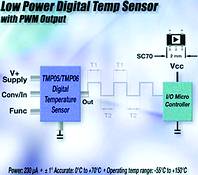Digital temperature sensors feature ±1°C accuracy and PWM output
23 April 2003
Analogue, Mixed Signal, LSI

Building upon the company's industry-leading expertise in converter technology, Analog Devices has introduced two digital temperature sensors with single-wire, pulse-width-modulation (PWM) outputs that it says offer the industry's most powerful combination of performance, low power consumption and small package size.
The output of the TMP05 and TMP06 is a square wave; its duty cycle is proportional to the absolute temperature. Both devices offer accuracy to ±1°C max from 0 to +70°C, an operating temperature range from -55 to +150°C, and a supply voltage range of +2,7 V to +5,5 V. They are available in space-saving 5-lead SC-70 and SOT-23 packages.
Both devices offer three modes of operation: daisy chain (allowing designers to connect any number of TMP05/06 sensors to the same microcontroller), continuously converting, and one-shot mode, which reduces the power consumption to 8,25 µW.
The TMP05 has a push-pull output (CMOS/TTL), while the TMP06 has an open-drain output.
Information from Analog Data Products. For more information contact them on 011 259 9400.
Further reading:
Online sensor technology hub
Analogue, Mixed Signal, LSI
Mouser’s sensor content hub offers an extensive collection of articles, blogs, eBooks, and product information from its technical experts and leading manufacturing partners.
Read more...
Ultra-low power MEMS accelerometer
Altron Arrow
Analogue, Mixed Signal, LSI
Analog Devices’ ADXL366 is an ultra-low power, 3-axis MEMS accelerometer that consumes only 0,96 µA at a 100 Hz output data rate and 191 nA when in motion-triggered wake-up mode.
Read more...
BT Audio 4 Click board
Dizzy Enterprises
Analogue, Mixed Signal, LSI
The BT Audio 4 Click board from MIKROE provides high-quality wireless audio streaming and data comms over Bluetooth.
Read more...
Precision MEMS IMU modules
Altron Arrow
Analogue, Mixed Signal, LSI
The ADIS16575/ADIS16576/ADIS16577 from Analog Devices are precision, MEMS IMUs that includes a triaxial gyroscope and a triaxial accelerometer.
Read more...
MEMS with embedded AI processing
Altron Arrow
Analogue, Mixed Signal, LSI
STMicroelectronics has announced an inertial measurement unit that combines sensors tuned for activity tracking and high-g impact measurement into a single, space-saving package.
Read more...
High-performance IMU
RS South Africa
Analogue, Mixed Signal, LSI
TDK Corporation has announced availability of the new InvenSense SmartMotion ICM-536xx family of high-performance 6-axis IMUs.
Read more...
High-temperature closed-loop MEMS accelerometer
RS South Africa
Analogue, Mixed Signal, LSI
This sensor from TDK is a high-temperature MEMS accelerometer with ±14 g input range and a digital interface for measurement while drilling applications.
Read more...
Dual accelerometers on the same die
Altron Arrow
Analogue, Mixed Signal, LSI
The LSM6DSV320X is the first mainstream inertial sensor to house a gyroscope alongside two accelerometers, one capable of sensing up to ±16 g and one sensing up to a staggering ±320 g.
Read more...
Dual-range IMU with edge processing
EBV Electrolink
Analogue, Mixed Signal, LSI
ST’s innovative LSM6DSV80X combines two accelerometer structures for 16 g and 80 g full-scale sensing, a gyroscope up 4000 dps, and embedded intelligence in a single component.
Read more...
High-reliability isolation amplifiers
EBV Electrolink
Analogue, Mixed Signal, LSI
The VIA series of isolation amplifiers from Vishay are designed to deliver exceptional thermal stability and precise measurement capabilities.
Read more...


